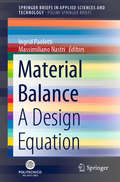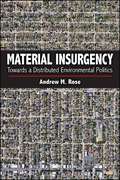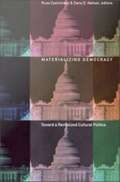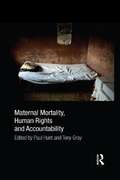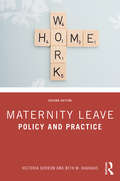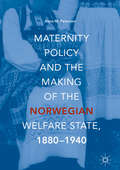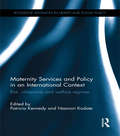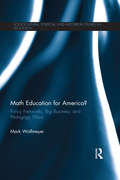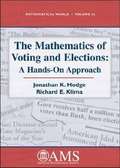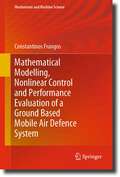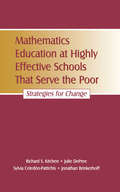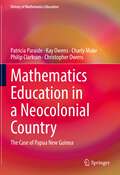- Table View
- List View
Material Balance: A Design Equation (SpringerBriefs in Applied Sciences and Technology)
by Ingrid Paoletti Massimiliano NastriThis book argues that we are living in an era of deep mutation, and the anthropocentric model no longer fits our way of living and behaving on Earth. Climate change is upsetting our relationship with nature and the environment, while artificial intelligence scenarios undermine the foundations of human life. As the pressure to re-align based on new modes of living and consuming increases, the first priority should be to address the way we imagine, design, produce and construct our built environment. The highly original book explores how the relation between design technology and material cultures can underpin and drive this change. It discusses the need for a new “material balance” to develop our design practice, not only from an energy and environmental perspective, but also from a physiological, cultural and semantic one, in order to re-balance the impact of material design on society. This publication is an excellent guide to understanding in detail the theoretical framing of several crucial topics in material balance design, from computational knitting to material agency, and from new acoustic ecology to future façade technologies, bio-based design and ultimately non-anthropocentric habitats, offering insights into preferable future scenarios.
Material Insurgency: Towards a Distributed Environmental Politics (SUNY series in New Political Science)
by Andrew M. RoseIn Material Insurgency, Andrew M. Rose examines emerging new materialist and posthuman conceptions of subjectivity and agency and explores their increasing significance for contemporary climate change environmentalism. Working at the intersection of material ecocriticism, posthuman theory, and environmental political theory, Rose critically focuses on the ways social movement organizing might effectively operate within the context of distributed agency. This concept undoes the privileging of rational human actors to suggest agency is better understood as a complex mixture of human and nonhuman forces. Rose explores various representations of distributed agency, from the pipeline politics of the Keystone XL campaign to the speculative literary fiction of Leslie Marmon Silko and Kim Stanley Robinson. Each of these cultural and literary texts provides a window into the possible constitution of a (distributed) environmental politics that does not yet exist and operates as a resource for envisioning environmental actors we cannot necessarily study empirically, because they are still only a prospect, or potential, of our imagination.
Materialist Feminism and the Politics of Discourse (Routledge Library Editions: Feminist Theory)
by Rosemary HennessyMaterialist Feminism and the Politics of Discourse confronts the impasses in materialist feminist work on rethinking ‘woman’ as a discursively constructed subject. The book looks at the problem of examining critically the social dimensions on which theories of discourse are premised: how such theories understand ‘materiality’; the relation between ‘women’s experience’ and feminist politics, and that between history and discourse. Rosemary Hennessy considers the work of Kristeva, Foucault, Laclau and Mouffe, and argues for a materialist feminist re-articulation of discourse as ideology. Concerns over identity and difference are incorporated into a rewriting of materialist feminism's analysis of women's oppression across capitalist and patriarchal structures. In adapting postmodernist theories in this way, Hennessy develops a project of social change, where feminism, while maintaining its specificity, is necessarily aligned with other emancipatory movements.
Materialität menschlicher Freiheiten: Gerechtigkeit als Bildungsauftrag: Relationen zwischen Umwelt und Sozialem gestalten
by Antje BrockEines der großen Ziele, an denen sich allgemeine Bildung ausrichtet, ist Gerechtigkeit. Werden Gerechtigkeitsfragen in Raum (lokal bis global) und Zeit ausgedehnt und soziale Kategorien mit der materiellen Umwelt verbunden, wird das Gebiet der nachhaltigen Entwicklung betreten. Entsprechende „Megatrends“ werden Gesellschaften gegenwärtig und in den nächsten Jahrzehnten herausfordern. So zentral es ist, Menschen durch Bildung in die Lage zu versetzen, die Zukunft auf Basis von Nachhaltigkeitsprinzipien mitzugestalten, so voraussetzungsreich ist diese Aufgabe. Beispielsweise birgt die Ausrichtung daran, tiefe Defizite überwinden zu müssen, emotional-motivationale Gefahren wie die von Hoffnungslosigkeit. Dem kann entgegengewirkt werden durch das Fokussieren auf „Pull-Effekte“ in der Bildung. Hierzu zählen das Gestalten attraktiver Zukünfte oder die Kraft „selbst-transzendierender“ Emotionen.Was gute nachhaltigkeitsbezogene Bildung bedeuten und wie diese trotz verschiedener Herausforderungen gelingen kann, wird hier anhand von theoretischen Perspektiven (u.a. dem capabilities approach, Bildungstheorien, Prozessphilosophie, New Materialism), empirischen Befunden und didaktischen Hinweisen dargestellt.
Materializing Democracy: Toward a Revitalized Cultural Politics
by Russ Castronovo Dana D. NelsonFor the most part, democracy is simply presumed to exist in the United States. It is viewed as a completed project rather than as a goal to be achieved. Fifteen leading scholars challenge that stasis in Materializing Democracy. They aim to reinvigorate the idea of democracy by placing it in the midst of a contentious political and cultural fray, which, the volume's editors argue, is exactly where it belongs. Drawing on literary criticism, cultural studies, history, legal studies, and political theory, the essays collected here highlight competing definitions and practices of democracy--in politics, society, and, indeed, academia. Covering topics ranging from rights discourse to Native American performance, from identity politics to gay marriage, and from rituals of public mourning to the Clinton-Lewinsky affair, the contributors seek to understand the practices, ideas, and material conditions that enable or foreclose democracy's possibilities. Through readings of subjects as diverse as Will Rogers, Alexis de Tocqueville, slave narratives, interactions along the Texas-Mexico border, and liberal arts education, the contributors also explore ways of making democracy available for analysis. Materializing Democracy suggests that attention to disparate narratives is integral to the development of more complex, vibrant versions of democracy. Contributors. Lauren Berlant, Wendy Brown, Chris Castiglia, Russ Castronovo, Joan Dayan, Wai Chee Dimock, Lisa Duggan, Richard R. Flores, Kevin Gaines, Jeffrey C. Goldfarb, Michael Moon, Dana D. Nelson, Christopher Newfield, Donald E. Pease
Maternal Fictions: Writing the Mother in Indian Women’s Fiction (Routledge Research in Postcolonial Literatures)
by Indrani KarmakarThis book constitutes a feminist literary analysis of motherhood as presented in selected Indian women’s fictions across a diverse range of geographical, linguistic, class and caste contexts. Situated at the crossroads of motherhood studies and literary studies, this book offers a rigorous examination of the prosody and politics of motherhood in this corpus. In its five thematically focused chapters, the book scrutinises in depth such key concerns as maternal ambivalence; maternal agency and caste; mother–daughter relationships; motherhood and diaspora; and non-biological motherhood. It attempts to understand the literary ramifications of these issues in order to identify the ways in which fiction writers reconceive of the notion of motherhood and maternal identities from and against multiple perspectives. Another pressing concern is whether these Indian women writers’ visions furnish readers with any different understandings of motherhood as compared to dominant Western feminist discourses. Maternal Fictions advances feminist literary criticism in the specific area of Indian women’s writing and the overarching areas of motherhood and literature by acting as a launchpad into a complex constellation of ideas concerning motherhood. The fictional universe is at once ambivalent, diverse, contingent, grounded in a specific location, and yet well placed to converse with discourses emanating from other times and places.
Maternal Megalomania: Julia Domna and the Imperial Politics of Motherhood
by Julie LangfordHow the maternal image of the empress Julia Domna helped the Roman empire rule.Ancient authors emphasize dramatic moments in the life of Julia Domna, wife of Roman emperor Septimius Severus (193–211). They accuse her of ambition unforgivable in a woman, of instigating civil war to place her sons on the throne, and of resorting to incest to maintain her hold on power. In imperial propaganda, however, Julia Domna was honored with unprecedented titles that celebrated her maternity, whether it was in the role of mother to her two sons (both future emperors) or as the metaphorical mother to the empire. Imperial propaganda even equated her to the great mother goddess, Cybele, endowing her with a public prominence well beyond that of earlier imperial women. Her visage could be found gracing everything from state-commissioned art to privately owned ivory dolls. In Maternal Megalomania, Julie Langford unmasks the maternal titles and honors of Julia Domna as a campaign on the part of the administration to garner support for Severus and his sons. Langford looks to numismatic, literary, and archaeological evidence to reconstruct the propaganda surrounding the empress. She explores how her image was tailored toward different populations, including the military, the Senate, and the people of Rome, and how these populations responded to propaganda about the empress. She employs Julia Domna as a case study to explore the creation of ideology between the emperor and its subjects.
Maternal Mortality, Human Rights and Accountability
by Tony Gray Paul HuntThe scale of maternal mortality and morbidity today is staggering. This book focuses on a vital part of a human rights response to maternal mortality, viz. accountability. Accountability encompasses monitoring, review and redress at the local, national and international levels. The book's context includes the UN Human Rights Council maternal mortality and morbidity resolutions, as well as Millennium Development Goal 5. It comes out of a roundtable conference held in Geneva during 2010 that examined maternal mortality, human rights and accountability and provided a forum where maternal health and human rights experts could listen to, and learn from, each other. As well as revised and updated conference papers, this volume includes a rich collection of additional resource material on maternal mortality, human rights and accountability.
Maternal Sentencing and the Rights of the Child (Palgrave Socio-Legal Studies)
by Shona MinsonThis book brings to life the experiences of children affected by maternal imprisonment, and provides unique, in-depth analysis of judicial thinking on this issue. It explores the experiences of children whose mothers are sentenced to imprisonment in England and Wales and contrasts their state-sanctioned separation from their mothers in the criminal courts (where the court may not even be aware of the existence of a child) to the state-sanctioned separation of children from their parents in the family courts, where the child has legal representation and their best interests are the court’s paramount consideration. Drawing on detailed empirical research with children, caregivers, and Crown Court judiciary, Maternal Sentencing and the Rights of the Child brings together relevant literature on law, criminology, and human rights to provide insight into the reasons for the differentiated treatment and its implications for children, their caregivers, and wider society.
Maternal Transition: A North-South Politics of Pregnancy and Childbirth (Routledge Research in Gender and Politics)
by Candace JohnsonWhat are the political dimensions that are revealed in women’s preferences for health care during pregnancy and childbirth? The answers to this question vary from one community to the next, and often from woman to the next, although the trends in the Global North and South are strikingly different. Employing three conceptual frames; medicalization, the public-private distinction, and intersectionality, Candace Johnson examines these differences through the narratives of women in Canada, the United States, Cuba, and Honduras. In Canada and the United States, women from privileged and marginalized social groups demonstrate the differences across the North-South divide, and women in Cuba and Honduras speak to the realities of severely constrained decision-making in developing countries. Each case study includes narratives drawn from in-depth interviews with women who were pregnant or who had recently had children. Johnson argues that women’s expressed preferences in different contexts reveal important details about the inequality that they experience in that context, in addition to as various elements of identity. Both inequality and identity are affected by the ways in which women experience the division between public and private lives – the life of the community and the life of the home and family – as well as the consequences of intersectionality – the combinations of various sources of disadvantage and women’s reactions to these, either in the form of resistance or compliance. The rigorous and highly original cross cultural and comparative research on health, gender, poverty and social context makes Maternal Transition an excellent contribution to global maternal health policy debates.
Maternity Leave: Policy and Practice
by Victoria Gordon Beth M. RauhausWhat does it mean to be a successful working parent? And how do working parents cope in the United States, the only developed nation with no paid parental leave requirement? Despite some positive advancement in the voluntary adoption of paid parental leave, many organizations over the past 25 years have instead decreased paid leave benefits offered to employees in the United States, choosing instead to let unpaid leave under the Family Medical Leave Act (FMLA) serve in its place. This regression in practice is perhaps the greatest unintended consequence of FMLA and surely was not the intent of Congress. Maternity Leave: Policy and Practice, Second Edition approaches parental leave from a variety of perspectives: legal, political, social, institutional, organizational, and, most importantly, from the personal perspectives of the women and men interviewed expressly for the book. This second edition offers two new chapters: the first puts the issue of maternity leave within the context of work–life balance issues, and the second explores case studies from states, cities, and private organizations. Incorporating new census data, related reports, and academic studies, authors Victoria Gordon and Beth M. Rauhaus utilize relevant and cutting-edge research in their exploration of parental leave, and they enrich this research with the individual stories of ordinary working parents as well as those who choose not to have children. Assuming no prior specialized knowledge, this book can be assigned on a variety of undergraduate and graduate courses in politics, public policy, public administration, gender studies, and human resource management, and will equally be of interest to parents, policy makers, and C-suite managers.
Maternity Policy and the Making of the Norwegian Welfare State, 1880-1940
by Anna M. PetersonThis book traces women’s influence on maternity policy in Norway from 1880-1940. Maternity policies, including maternity leave, midwifery services and public assistance for mothers, were some of the first welfare policies enacted in Norway. Feminists, midwives, and working women participated in their creation and helped transform maternity policies from a restriction to a benefit. Situating Norway within the larger European context, the book contributes to discussions of Scandinavian welfare state development and further untangles the relationship between social policy and gender equality.The study of poor, rural women alongside urban middle-class feminists is rooted in an inclusive archival source base that speaks to the interplay between local and national welfare officials and recipients, the development and implementation of laws in diverse settings, the divergent effects maternity policies had on women, and women’s varied response.
Maternity Services and Policy in an International Context: Risk, Citizenship and Welfare Regimes
by Patricia Kennedy Naonori KodateThis book is the first comprehensive international overview of maternity services. Drawing on concepts of risk and social citizenship, it explores the relationship between welfare regimes and health policy by comparing and contrasting provision for childbearing women. Each substantive chapter focuses on a different country, presenting detailed contextual information on health care provision, maternity interventions and birth outcomes there. They discuss key issues such as birth rates and fertility patterns, the role of patient choice, attitudes to place of birth and maternity entitlements among others, and the countries covered represent diverse welfare regimes, including Ireland, Scotland, Sweden, the Netherlands, Germany, Italy, Japan, the United States, Canada, Australia and New Zealand. An extended introduction and a conclusion draw the book together and place it in the context of the literature on comparative welfare regimes. It is an important reference for students and academics interested in comparative social policy, health services research, and maternity services and policies.
Math Education for America?: Policy Networks, Big Business, and Pedagogy Wars (Sociocultural, Political, and Historical Studies in Education)
by Mark WolfmeyerMath Education for America? analyzes math education policy through the social network of individuals and private and public organizations that influence it in the United States. The effort to standardize a national mathematics curriculum for public schools in the U.S. culminated in 2010 when over 40 states adopted the Common Core State Standards for Mathematics. Rather than looking at the text of specific policy documents, this book complements existing critical reviews of the national math education curriculum by employing a unique social network analysis. Breaking new ground in detailing and theorizing the politics of math education, Wolfmeyer argues that the private interests of this network are closely tied to a web of interrelated developments: human capital education policy, debates over traditional and reform pedagogy, the assumed content knowledge deficit of math teachers, and the proliferation of profit-driven educational businesses. By establishing the interconnectedness of these interests with the national math education curriculum, he shows how the purported goals of math education reform are aligned with the prevailing political agendas of this social network rather than the national interest.
Math in FocusTM: The Singapore Approach, Student Book, 3B
by Fong Ho Kheong Chelvi Ramakrishnan Michelle ChooNIMAC-sourced textbook
Math of Voting and Elections: A Hands-on Approach
by Jonathan K. Hodge Richard E. KlimaThis book is devoted to the mathematics of politics and social choice and is a junior /senior level course aimed at students from a variety of mathematical backgrounds.
Mathematical Modelling Programs in Latin America: A Collaborative Context for Social Construction of Knowledge for Educational Change
by Milton Rosa Daniel Clark Orey Francisco Cordero Pablo CarranzaThis book is about the unique, sophisticated, and rigorous study of mathematics in Latin America developed over centuries of cultural exchange between Europe, North, and South America. More specifically, the book explores the tradition of mathematical modelling, introduced a century ago. This modelling was adapted to assist members of distinct communities to draw information about their own realities through the elaboration of representations, which generate mathematical knowledge that deals with creativity and invention. The book provides empirical evidence that a category of mathematical modelling developed in Latin America assesses the horizontal and reciprocal relations between mathematics (school/non-school contexts) and the real world. These relations provide an epistemological and ontological change, where mathematical knowledge of the others is recognized on a horizontal plane. Further, they oblige mathematics teachers and students to understand as a community of knowledge that builds their own mathematical categories of their environment governed by the reciprocal relationships between academic knowledge and functional knowledge. The dimensions of the relationships make up a frame of reference that guides educational change in mathematics. The book presents an inquiry-based approach of three Latin American modelling programs: ethnomodelling, transversality of knowledge, and reasoned decision-making. Each one, with its respective theoretical and methodological foundations related to ethnomathematics and mathematical modelling, socioepistemology, and the attribution of meaning to learning. Undoubtedly, the three mathematical modelling programs, independently, provide educational gains, each with its levels of specificity and loyal to its philosophical, theoretical, and methodological principles. However, the book places them together, organized by axes, to define a corpus of mathematical knowledge that envisions profound educational change through the development of different approaches of mathematical modelling. The authors of the 18 chapters in this book, who represent the diversity of Latin America, are from eight countries: Argentina, Brazil, Chile, Colombia, Costa Rica, Cuba, Ecuador, Honduras, and Mexico. They were invited to share their ideas, perspectives, and discuss investigations that represent a rich sample of three Latin American perspectives on mathematical modelling.
Mathematical Modelling, Nonlinear Control and Performance Evaluation of a Ground Based Mobile Air Defence System (Mechanisms and Machine Science #76)
by Constantinos FrangosIn this book, the author deals with the mathematical modelling, nonlinear control and performance evaluation of a conceptual anti-aircraft gun based mobile air defence system engaging an attacking three-dimensional aerial target.This book is of interest to academic faculty, graduate students and industry professionals working in the fields of mathematical modelling and control, ground vehicles, mobile air defence systems and other related topics.
Mathematics Education at Highly Effective Schools That Serve the Poor: Strategies for Change
by Jonathan Brinkerhoff Richard S. Kitchen Julie DePree Sylvia Celed¢n-PattichisThis book presents research findings about school-level and district-level practices and successful strategies employed in mathematics education by highly effective schools that serve high-poverty communities. It includes both the theory and practice of creating highly effective schools in these communities. In 2002 nine schools were selected in a national competition to participate in the Hewlett-Packard High Achieving Grant Initiative. As part of this Initiative, these schools participated in the research study this book reports. The study employed both qualitative and quantitative methodologies to examine school- and classroom-level factors that contributed to high achievement, particularly in mathematics. The goals of the study were twofold: 1) to investigate the salient characteristics of the highly effective schools in which the research was conducted, and 2) to explore participating teachers’ conceptions and practices about mathematics curriculum, instruction, and assessment. The schools described have much to teach about creating powerful learning environments that empower all students to learn challenging mathematics. Given the pressures of the accountability measures of the No Child Left Behind legislation, this book is extremely timely for those seeking school models that serve high-poverty communities and have demonstrated high performance on high-stakes examinations and other assessments. Mathematics Education at Highly Effective Schools That Serve the Poor: Strategies for Change is particularly relevant for teacher educators, researchers, teachers, and graduate students in the fields of mathematics education and school policy and reform, and for school administrators and district coordinators of mathematics education.
Mathematics Education in East Africa: Towards Harmonization and Enhancement of Education Quality (SpringerBriefs in Education)
by Anjum Halai Geoff TennantThis Open Access book is a valuable resource for policymakers and practitioners as it brings insights mainly from developing countries where relatively less research activity takes place. It is also a valuable resource for courses in mathematics education in the teacher education colleges, and departments of education in the sub-Saharan Africa region. In the increasingly global and technological world mathematics is seen as a significant gatekeeper of opportunities for social and economic advancement and mobility. Hence, countries and development agencies in the broader sub-Saharan Africa region are looking towards increasing access to relevant and high-quality secondary education as a lever towards economic development. Policy makers and other key decision makers in education look towards improvement in mathematics teaching and learning as a key focus in education reform. In the East Africa region also a number of initiatives have been taken at the national level in the respective countries to improve the quality of mathematics education. This book provides an in-depth comparative analysis of the developments and issues in mathematics education in Kenya, Tanzania, Rwanda and Uganda, and advances our understanding of the state of secondary mathematics education in East Africa.
Mathematics Education in a Neocolonial Country: The Case of Papua New Guinea (History of Mathematics Education)
by Philip Clarkson Kay Owens Patricia Paraide Charly Muke Christopher OwensMost education research is undertaken in western developed countries. While some research from developing countries does make it into research journals from time to time, but these articles only emphasize the rarity of research in developing countries. The proposed book is unique in that it will cover education in Papua New Guinea over the millennia. Papua New Guinea’s multicultural society with relatively recent contact with Europe and the Middle East provides a cameo of the development of education in a country with both a colonial history and a coup-less transition to independence. Discussion will focus on specific areas of mathematics education that have been impacted by policies, research, circumstances and other influences, with particular emphasis on pressures on education in the last one and half centuries. This volume will be one of the few records of this kind in the education research literature as an in-depth record and critique of how school mathematics has been grown in Papua New Guinea from the late 1800s, and should be a useful addition to graduate programs mathematics education courses, history of mathematics, as well as the interdisciplinary fields of cross cultural studies, scholarship focusing on globalization and post / decolonialism, linguistics, educational administration and policy, technology education, teacher education, and gender studies.
Mathematics Teacher Preparation in Central America and the Caribbean: The Cases of Colombia, Costa Rica, the Dominican Republic and Venezuela (SpringerBriefs in Education)
by Angel RuizThis Open Access book is an excellent synthesis of the initial and continuing preparation for Mathematics Teaching in Colombia, Costa Rica, Dominican Republic and Venezuela, from which comparative analyses can be made that show similarities and differences, and highlight various perspectives.In August 2012, a workshop of the Capacity and Networking Project (CANP) of the International Commission on Mathematical Instruction (ICMI) was held in Costa Rica. This CANP brought together for two weeks a group of 66 Mathematics educators, mathematicians, university administrators, and elementary and secondary teachers from Colombia, Venezuela, the Dominican Republic, Panamá and Costa Rica. The goal was to promote progress in Mathematics Education in the region; as such it was a unique experience in the region. One of the most important results of this event was the creation of the Mathematics Education Network of Central America and the Caribbean (REDUMATE). It was organized by persons associated with the Mathematics Education Reform Project in Costa Rica (responsible for the most outstanding and innovative curriculum reform in Latin America) and the Inter-American Committee on Mathematics Education (IACME), which is an official regional multinational organization affiliate of ICMI.This book brings to the international Educational Community an important collection of experiences and ideas in the Mathematics Education of four countries of a region within the heart of the American continent, a region that has been many times forgotten. The dissemination of these results can promote the search for international collaborative actions in a wider scale.
Mathematics in Politics and Governance
by Miguel A. Goberna Francisco J. Aragón-ArtachoThis book presents the mathematical tools that politicians use to make rational decisions about health, education, culture, economy, finance, transportation, and national defense for their citizens. The selection of topics addressed is based on the experiences of four veteran politicians who have doctorates or master’s degrees in mathematics. The exposition also considers the mathematical tools used by politicians to capture votes or optimize their impact on the design of electoral districts, i.e., gerrymandering, without forgetting the mathematics applied to parliamentary activity and political science.Aimed at a general educated readership, a basic knowledge of mathematics is the only requisite to understanding most of the book. Certain sections, denoted in the book with a star, contain more advanced material and require some knowledge of undergraduate math. A later chapter is dedicated to applications and techniques of machine learning and the final chapter discusses a variety of cases where political decisions have affected mathematical development. Readers gravitating towards this book are those who are curious about the history of mathematics, including optimizers and mathematicians who would like to learn more about the historical roots of their discipline. There will also be strong appeal to mathematically-oriented economists, political scientists, and people generally interested in mathematics.Mathematics is – or it should be! – an important part of our culture. The impact of mathematics is sometimes silent, but a powerful one. The authors of this book did an incredible work in digging out areas of mathematical reasoning that pervades social and political life. Reading this book, we will all enrich our vision of mathematics’ value for society.(Nuno Crato, Professor of Applied Mathematics, University of Lisbon, former minister of Education and Science of Portugal 2011–2015)This monograph shows in an impressive way that mathematics can be very helpful in making and evaluating political decisions and that it is indispensable in the progressive penetration of all areas of society with scientific methods. This also includes politics. Not everything in politics can be justified or related to mathematics, but politics should not be made in contradiction to mathematical truths. For me, this is a central message of this publication.(Johanna Wanka, Professor of Applied Mathematics, Merseburg University of Applied Sciences, former Minister of Education and Research, Germany 2013–2018)
Mathematics to the Rescue of Democracy: What does Voting Mean and How can it be Improved?
by Paolo SerafiniThis book explains, in a straightforward way, the foundations upon which electoral techniques are based in order to shed new light on what we actually do when we vote. The intention is to highlight the fact that no matter how an electoral system has been designed, and regardless of the intentions of those who devised the system, there will be goals that are impossible to achieve but also opportunities for improving the situation in an informed way. While detailed descriptions of electoral systems are not provided, many references are made to current or past situations, both as examples and to underline particular problems and shortcomings. In addition, a new voting method that avoids the many paradoxes of voting theory is described in detail. While some knowledge of mathematics is required in order to gain the most from the book, every effort has been made to ensure that the subject matter is easily accessible for non-mathematicians, too. In short, this is a book for anyone who wants to understand the meaning of voting.

